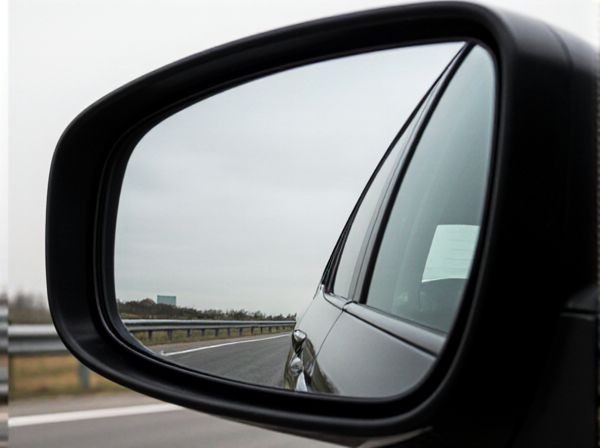
Photo illustration: Electrochromic vs Manual-Dimming
Electrochromic tint allows windows to automatically adjust their shade based on external light conditions, providing seamless control and improved energy efficiency. Manual-dimming requires you to physically adjust a shade or screen to reduce glare and heat, offering less convenience but often lower upfront costs. Both options enhance comfort and visibility, but electrochromic technology delivers superior precision and ease of use.
Table of Comparison
| Feature | Electrochromic Mirror | Manual-Dimming Mirror |
|---|---|---|
| Technology | Auto-dimming via electrochromic gel | Manual flip or lever adjustment |
| Glare Reduction | Automatic, adaptive to light intensity | Manual control, limited precision |
| Convenience | Hands-free operation | Requires manual adjustment |
| Cost | Higher initial cost | Lower cost, budget-friendly |
| Durability | Long-lasting with maintenance | Simple, fewer components |
| Application | Premium and modern vehicles | Standard and economy vehicles |
Introduction to Electrochromic and Manual-Dimming Technologies
Electrochromic technology uses electrically controlled materials to change the tint on glass surfaces, providing adaptive light filtering and glare reduction in automotive and architectural applications. Manual-dimming relies on physical mechanisms like a rotating mirror or lever to adjust the reflectivity of rearview mirrors, offering straightforward glare control without electrical input. Electrochromic systems deliver automatic, variable tinting for enhanced comfort and safety, while manual-dimming mirrors offer cost-effective, user-controlled glare reduction solutions.
How Electrochromic Windows Work
Electrochromic windows utilize a thin, multi-layer coating that changes tint in response to a low-voltage electrical current, controlling the amount of light and heat passing through. This technology adjusts automatically or via user control, improving energy efficiency by reducing glare and solar heat gain without compromising outside views. Compared to manual-dimming windows, which require physical adjustment, electrochromic systems provide seamless, real-time modulation of window transparency for enhanced comfort and building performance.
Understanding Manual-Dimming Systems
Manual-dimming systems rely on a simple prismatic mirror and a lever that physically adjusts the mirror's angle to reduce glare from headlights at night. These systems do not require electrical power, making them more affordable and less complex but less responsive compared to electrochromic mirrors. Electrochromic mirrors utilize an electrochemical process to darken the mirror automatically in response to light sensors, offering convenience and enhanced safety through adaptive glare reduction.
Key Advantages of Electrochromic Solutions
Electrochromic mirrors offer precise, automatic glare reduction by adjusting tint levels in response to light intensity, enhancing driver comfort and safety compared to manual-dimming mirrors that require manual adjustment. These mirrors improve visibility and reduce eye strain during nighttime driving through continuous, real-time light modulation controlled by built-in sensors. Electrochromic technology also enhances durability and aesthetics with a sleek, seamless design free from manual toggles or switches.
Benefits of Manual-Dimming Options
Manual-dimming mirrors provide precise control over glare reduction by allowing drivers to adjust the mirror's angle based on real-time lighting conditions, enhancing safety during nighttime driving. These mirrors typically offer a cost-effective and reliable solution without the need for electrical components, resulting in fewer maintenance issues over time. Furthermore, manual-dimming options provide straightforward functionality that appeals to drivers seeking simplicity and durability in their vehicle accessories.
Energy Efficiency Comparison
Electrochromic windows offer superior energy efficiency compared to manual-dimming systems by automatically adjusting tint levels based on sunlight intensity, reducing heating and cooling loads effectively. This dynamic control decreases reliance on HVAC systems, leading to significant energy savings and lower utility costs in both residential and commercial buildings. Manual-dimming methods lack this adaptive technology, often resulting in inconsistent shading and higher overall energy consumption.
Installation and Maintenance Requirements
Electrochromic mirrors require more complex installation involving wiring and integration with the vehicle's electrical system, whereas manual-dimming mirrors offer straightforward, plug-and-play setup with minimal tools. Maintenance for electrochromic mirrors may include periodic inspections of electrical components and potential recalibration, while manual-dimming mirrors generally need only occasional cleaning and mechanical checks. The intricate technology of electrochromic systems can lead to higher long-term service costs compared to the simplicity and durability of manual-dimming alternatives.
Cost Analysis: Initial and Long-Term Expenses
Electrochromic mirrors typically have higher initial costs due to advanced technology and integration with vehicle electronics, averaging $200 to $400 compared to $50 to $150 for manual-dimming mirrors. Long-term expenses for electrochromic mirrors include potential repair or replacement of electronic components, but they offer benefits like automatic glare reduction, reducing the need for manual adjustments and enhancing safety. Manual-dimming mirrors have lower upfront costs and minimal maintenance but may incur indirect costs related to reduced driver comfort and increased eye strain over time.
User Experience and Control Flexibility
Electrochromic mirrors provide seamless automatic tint adjustments based on ambient light, enhancing user experience by reducing glare without manual intervention. Manual-dimming mirrors require physical effort to adjust, offering users direct control but less convenience during changing light conditions. Electrochromic technology ensures continuous adaptation with personalized sensitivity settings, while manual mirrors rely on user attention and timely adjustments.
Choosing the Right Solution for Your Needs
Electrochromic mirrors automatically adjust tint based on light intensity, providing enhanced visibility and reducing glare for safer nighttime driving. Manual-dimming mirrors require physical adjustment, offering a cost-effective option for drivers who prefer direct control over mirror glare. Choosing the right solution depends on your budget, driving habits, and preference for convenience versus manual customization.
 caratoz.com
caratoz.com